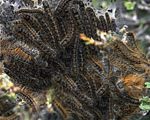Caterpillar
The image corresponds to a Banded Wooley Bear caterpillar
Human health risks
Caterpillar hair has been known to be a cause of human health problems. Caterpillar hairs sometimes have venoms in them and species from approximately 12 families of moths or butterflies worldwide can inflict serious human injuries ranging from urticarial dermatitis and atopic asthma to osteochondritis, consumption coagulopathy, renal failure, and intracerebral hemorrhage.
Skin rashes are the most common, but there have been fatalities. Lonomia is a frequent cause of death in Brazil with 354 cases were reported between 1989 and 2005. Lethality ranging up to 20% with death caused most often by intracranial hemorrhage.
Caterpillar hairs have also been known to cause kerato-conjunctivitis. The sharp barbs on the end of
Caterpillar hairs can get lodged in soft tissues and mucus membranes such as the eyes. Once they enter such tissues, they can be difficult to extract, often exacerbating the problem as they migrate across the membrane.
This becomes a particular problem in an indoor setting. The hairs easily enter buildings through ventilation systems and accumulate in indoor environments because their small size, which makes it difficult for them to be vented out. This accumulation increases the risk of human contact in indoor environments.
Economic effects
Caterpillars cause much damage, mainly by eating leaves. The propensity for damage is enhanced by monocultural farming practices, especially where the caterpillar is specifically adapted to the host plant under cultivation. The cotton bollworm causes enormous losses. Other species eat food crops. Caterpillars have been the target of pest control through the use of pesticides, biological control and agronomic practices. Many species have become resistant to pesticides. Bacterial toxins such as those from Bacillus thuringiensis which are evolved to affect the gut of Lepidoptera have been used in sprays of bacterial spores, toxin extracts and also by incorporating genes to produce them within the host plants. These approaches are defeated over time by the evolution of resistance mechanisms in the insects.
Plants evolve mechanisms of resistance to being eaten by caterpillars, including the evolution of chemical toxins and physical barriers such as hairs. Incorporating host plant resistance (HPR) through plant breeding is another approach used in reducing the impact of caterpillars on crop plants.
Some caterpillars are used in industry. The silk industry is based on the silkworm caterpillar.

Gipsy Moth

Tent Caterpillar

